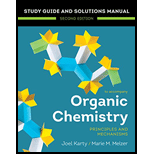
Concept explainers
(a)
Interpretation:
In the given figure, every region of constructive interference and destructive interference between the HOMO and LUMO is to be labeled.
Concept introduction:
The HOMO-LUMO orbital interaction concept is used to know how the reacting species interact. The electron-rich species is HOMO while the electron-deficient species is LUMO; they determine substantial net overlap in the transition state. When these two orbitals overlap with the same phases, the constructive interference occurs and the reaction is likely to be allowed. When these two orbitals overlap with the opposite phases, the destructive interference occurs and the reaction is likely to be not allowed (or forbidden).
(b)
Interpretation:
In the given figure, every region of constructive interference and destructive interference between the HOMO and LUMO is to be labeled.
Concept introduction:
The HOMO-LUMO orbital interaction concept is used to know how the reacting species interact. The electron-rich species is HOMO while the electron-deficient species is LUMO; they determine substantial net overlap in the transition state. When these two orbitals overlap with the same phases, the constructive interference occurs and the reaction is likely to be allowed. When these two orbitals overlap with the opposite phases, the destructive interference occurs and the reaction is likely to be not allowed (or forbidden).
Want to see the full answer?
Check out a sample textbook solution
Chapter D Solutions
EBK ORGANIC CHEMISTRY: PRINCIPLES AND M
- Organic Functional Groups Predicting the reactants or products of acetal hydrolysis termine the structures of the missing organic molecules in the following reaction: H* H* + H₂O Y ☑ Note: Molecules that share the same letter have the exact same structure. In the drawing area below, draw the skeletal ("line") structures of the missing organic molecules X, Y, and Z. You may draw that you like, so long as they aren't touching. Molecule X shows up in multiple steps, but you only have to draw its structure Explanation Check @2 W Click and drag to start drawing a structure. #4 # 3 LU E % 67 olo 5 66 R T Y & 7 AcGraw Hill LLC. All Rights R Xarrow_forward8. (16 pts) Provide the stepwise mechanism for the synthesis of the following compound via an enaminearrow_forwardDraw the titration curve of (i) weak acid vs. strong base; (ii) weak acid vs. weakbase; (iii) diprotic acid with strong base (iii) triprotic acid with strong base.arrow_forward
 Organic Chemistry: A Guided InquiryChemistryISBN:9780618974122Author:Andrei StraumanisPublisher:Cengage Learning
Organic Chemistry: A Guided InquiryChemistryISBN:9780618974122Author:Andrei StraumanisPublisher:Cengage Learning
